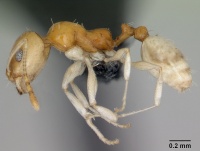Royidris pallida
| Royidris pallida | |
|---|---|

| |
| Scientific classification | |
| Kingdom: | Animalia |
| Phylum: | Arthropoda |
| Class: | Insecta |
| Order: | Hymenoptera |
| Family: | Formicidae |
| Subfamily: | Myrmicinae |
| Tribe: | Crematogastrini |
| Genus: | Royidris |
| Species group: | robertsoni |
| Species: | R. pallida |
| Binomial name | |
| Royidris pallida Bolton & Fisher, 2014 | |
Known only from the holotype, this beautiful little species is known from a single specimen - a nocturnal forager collected at a light trap.
Identification
A member of the robertsoni species group. Bolton and Fisher (2014) - Within the robertsoni group, pallida is recognised by its pale colour, smooth head, lack of a metanotal groove, relatively short scapes, and relatively slender metafemora.
Keys including this Species
Distribution
Endemic to Madagascar.
Latitudinal Distribution Pattern
Latitudinal Range: -22.8° to -22.8°.
| North Temperate |
North Subtropical |
Tropical | South Subtropical |
South Temperate |
- Source: AntMaps
Distribution based on Regional Taxon Lists
Malagasy Region: Madagascar (type locality).
Distribution based on AntMaps
Distribution based on AntWeb specimens
Check data from AntWeb
Countries Occupied
| Number of countries occupied by this species based on AntWiki Regional Taxon Lists. In general, fewer countries occupied indicates a narrower range, while more countries indicates a more widespread species. |

|
Estimated Abundance
| Relative abundance based on number of AntMaps records per species (this species within the purple bar). Fewer records (to the left) indicates a less abundant/encountered species while more records (to the right) indicates more abundant/encountered species. |

|
Biology
Castes
Known only from the worker caste.
Nomenclature
The following information is derived from Barry Bolton's Online Catalogue of the Ants of the World.
- pallida. Royidris pallida Bolton & Fisher, 2014: 59, figs. 63-65 (w.) MADAGASCAR.
- Type-material: holotype worker.
- Type-locality: Madagascar: Prov. Toliara, Forêt Tsinjoriaky, 6.2 km. 84° E Tsifota, 70 m., 22°48’S, 43°25’E, 6-10.iii.2002, BLF 5967, CASENT0085017, at light, spiny forest thicket (B.L. Fisher et al).
- Type-depository: CASC.
- Distribution: Madagascar.
Unless otherwise noted the text for the remainder of this section is reported from the publication that includes the original description.
Description
Worker
Holotype. TL 2.5, HL 0.59, HW 0.50, CI 85, SL 0.50, SI 100, PW 0.34, WL 0.72.
Antennal club 3-segmented. Mandible with superficial longitudinal costulae and scattered pits. Scapes relatively short (SI 100); when laid straight back in full-face view the apex of the scape just exceeds the posterior margin of the head. With head in full-face view the eyes very close to the midlength of the side of the head capsule. EL 0.14 (EL/HW 0.28). Dorsum of head from level of eyes to posterior margin smooth and polished; at high magnification some vestiges of superficial reticular patterning are visible, which appear to be the last traces of an almost entirely effaced microreticular pattern. Promesonotum in profile convex and swollen, domed, the mesonotum posteriorly descends abruptly to the commencement of the propodeum, the metanotal groove is absent. In absolute profile the propodeal dorsum is very slightly concave in its anterior one-third, slightly convex in its posterior two-thirds, and ends posteriorly in a bluntly reinforced angle that slightly overhangs the shallowly concave declivity. The whole propodeal dorsum is strongly depressed with respect to the highest point of the promesonotum, which is on a considerably higher level. Dorsa of pronotum and mesonotum each with 2 pairs of setae; dorsum of propodeum lacks setae. Promesonotal dorsum smooth and shining, with vestigial traces of microreticular patterning. Propodeal dorsum very feebly sculptured, but distinctly more strongly than the pronotum. Mesopleuron and metapleuron weakly shagreenate to very feebly, superficially reticulate-punctulate. Metafemur relatively slender, MfL 0.56 (MfL/HW 1.12, MfL/MfH 5.60). Petiole with a pair of setae on the posterior face of the node; postpetiole with a pair dorsally and a transverse row of 4 posteriorly; first gastral tergite with short setae that are quite densely scattered over the entire dorsum. Postpetiole relatively narrow in dorsal view, maximum width 0.22 (0.36 × HW). Dorsum of postpetiole and first gastral tergite unsculptured. Colour of head, mesosoma, petiole and postpetiole yellow, the legs and gaster conspicuously lighter, extremely pale yellow to almost white.
Type Material
Holotype worker, Madagasacar: Prov. Toliara, Forêt Tsinjoriaky, 6.2 km. 84° E Tsifota, 22°48’S, 43°25’E, 70 m., 6–10.iii.2002, BLF 5967, CASENT0085017, at light, spiny forest/thicket (Fisher et al.) (California Academy of Sciences).
References
- Bolton, B. & Fisher, B.L. 2014. The Madagascan endemic myrmicine ants related to Eutetramorium (Hymenoptera: Formicidae): taxonomy of the genera Eutetramorium Emery, Malagidris nom. n., Myrmisaraka gen. n., Royidris gen. n., and Vitsika gen. n. Zootaxa 3791:1–99. doi:10.11646/zootaxa.3791.1.1

